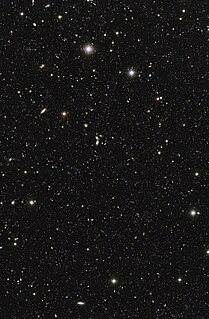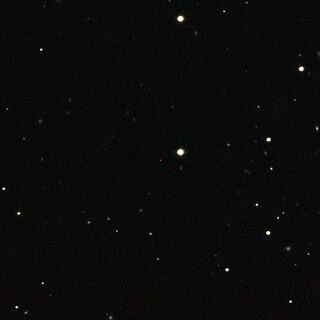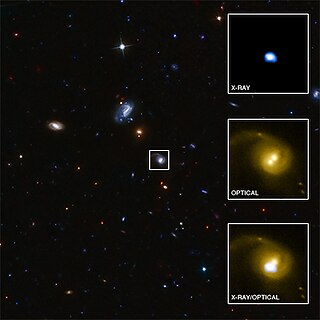Related Research Articles

A quasar is an extremely luminous active galactic nucleus (AGN), in which a supermassive black hole with mass ranging from millions to billions of times the mass of the Sun is surrounded by a gaseous accretion disk. As gas in the disk falls towards the black hole, energy is released in the form of electromagnetic radiation, which can be observed across the electromagnetic spectrum. The power radiated by quasars is enormous: the most powerful quasars have luminosities thousands of times greater than a galaxy such as the Milky Way. Usually, quasars are categorized as a sub-class of the more general category of AGN. The redshifts of quasars are of cosmological origin.

3C 273 is a quasar located in the constellation of Virgo. It was the first quasar ever to be identified.

A supermassive black hole is the largest type of black hole, with mass on the order of millions to billions of times the mass of the Sun (M☉). Black holes are a class of astronomical objects that have undergone gravitational collapse, leaving behind spheroidal regions of space from which nothing can escape, not even light. Observational evidence indicates that almost every large galaxy has a supermassive black hole at the galaxy's center. The Milky Way has a supermassive black hole in its Galactic Center, which corresponds to the location of Sagittarius A*. Accretion of interstellar gas onto supermassive black holes is the process responsible for powering active galactic nuclei and quasars.

A blazar is an active galactic nucleus (AGN) with a relativistic jet directed very nearly towards an observer. Relativistic beaming of electromagnetic radiation from the jet makes blazars appear much brighter than they would be if the jet were pointed in a direction away from Earth. Blazars are powerful sources of emission across the electromagnetic spectrum and are observed to be sources of high-energy gamma ray photons. Blazars are highly variable sources, often undergoing rapid and dramatic fluctuations in brightness on short timescales. Some blazar jets exhibit apparent superluminal motion, another consequence of material in the jet traveling toward the observer at nearly the speed of light.

NGC 3115 is a field lenticular (S0) galaxy in the constellation Sextans. The galaxy was discovered by William Herschel on February 22, 1787. At about 32 million light-years away from Earth, it is several times bigger than the Milky Way. It is a lenticular (S0) galaxy because it contains a disk and a central bulge of stars, but without a detectable spiral pattern. NGC 3115 is seen almost exactly edge-on, but was nevertheless mis-classified as elliptical. There is some speculation that NGC 3115, in its youth, was a quasar.
APM 08279+5255 is a very distant, broad absorption line quasar located in the constellation Lynx. It is magnified and split into multiple images by the gravitational lensing effect of a foreground galaxy through which its light passes. It appears to be a giant elliptical galaxy with a supermassive black hole and associated accretion disk. It possesses large regions of hot dust and molecular gas, as well as regions with starburst activity.
The Cloverleaf quasar is a bright, gravitationally lensed quasar.

The Chandra Deep Field South (CDF-S) is an image taken by the Chandra X-ray Observatory satellite. The location was chosen because, like the Lockman Hole, it is a relatively clear "window" through the ubiquitous clouds of neutral hydrogen gas in our Milky Way galaxy, which allows us to clearly see the rest of the universe in X-rays. The image is centered on RA 3h 32m 28.0s DEC −27° 48′ 30″ (J2000.0), covering 0.11 square degrees, measuring 16 arcminutes across. This patch of sky lies in the Fornax constellation.
An extragalactic planet, also known as an extragalactic exoplanet, is a star-bound planet or rogue planet located outside of the Milky Way Galaxy. Due to the huge distances to such worlds, they would be very hard to detect directly. However, indirect evidence suggests that such planets may exist. Nonetheless, the most distant known planets are SWEEPS-11 and SWEEPS-04, located in Sagittarius, approximately 27,710 light-years from the Sun, while the Milky Way is between 100,000 and 180,000 light years in diameter. This means that even galactic planets located farther than that distance have not been detected.
SDSS J0303-0019 is a distant quasar in the z≥6 regime. It is one of the first two quasars discovered that appear to be "dust-free", the other being QSO J0005-0006.

ULAS J1120+0641 is the second most distant known quasar as of 6 December 2017, after ULAS J1342+0928. ULAS J1120+0641 was the first quasar discovered beyond a redshift of 7. Its discovery was reported in June 2011.

CID-42 is a galaxy quasar about 3.9 billion light years away in the constellation Sextans. It is believed to have a supermassive black hole at its center.

RX J1131-1231 is a distant, supermassive-black-hole-containing quasar located about 6 billion light years from Earth in the constellation Crater.

S5 0014+81 is a distant, compact, hyperluminous, broad-absorption-line quasar, or blazar, located near the high declination region of the constellation Cepheus, near the North Equatorial Pole.
SDSS J0100+2802 (SDSS J010013.02+280225.8) is a hyperluminous quasar located near the border of the constellations Pisces and Andromeda. It has a redshift of 6.30, which corresponds to a distance of 12.8 billion light-years from Earth and was formed 900 million years after the Big Bang. And it appears to diverge at a velocity of 1.3782e+8 m/s. It unleashes an immense amount of power equivalent to 3×1041 watts, which corresponds to the absolute bolometric magnitude of -31.7 which is 4.3×1014 times the luminosity of the Sun, and 40,000 times as luminous as all of the 400 billion stars of the Milky Way galaxy combined. SDSS J0100+2802 is about four times more luminous than SDSS J1148+5251, and seven times more luminous than ULAS J1120+0641, the most distant quasar known, although it is only less than fourth as luminous as HS 1946+7658, the most luminous quasar known. It harbors a black hole with mass of 12 billion solar masses (estimated (1.24±0.19)×1010M☉ according to MgII emission line correlations). This makes it one of the most massive black holes discovered so early in the universe, although it is only less than one fifth as massive as TON 618, the most massive black hole known. The diameter of this black hole is about 70.9 billion kilometres, seven times the diameter of Pluto's orbit.
TON 618 is a very distant and extremely luminous quasar—technically a hyperluminous, broad-absorption line, radio-loud quasar—located near the North Galactic Pole in the constellation Canes Venatici. TON 618 is currently the most massive black hole ever found with a mass of 66 billion M☉.

ULAS J1342+0928 is the most distant known quasar detected and contains the most distant and oldest known supermassive black hole, at a reported redshift of z = 7.54, surpassing the redshift of 7 for the previously known most distant quasar ULAS J1120+0641. The ULAS J1342+0928 quasar is located in the Boötes constellation. The related supermassive black hole is reported to be "800 million times the mass of the Sun".
SMSS J215728.21-360215.1, commonly known as J2157-3602, is one of the fastest growing black holes and one of the most powerful quasars known to exist as of 2018. The quasar is located at redshift 4.75, corresponding to a comoving distance of 25×109 ly from Earth and to a light-travel distance of 12.5×109 ly. It was discovered with the SkyMapper telescope at Australian National University's Siding Spring Observatory, announced in May 2018. It has an intrinsic bolometric luminosity of 6.95×1014 L☉ (2.66×1041 W).
Pōniuāʻena is the second most-distant quasar known, with a measured redshift of z = 7.52 or a lookback time of 13.02 billion years. Its 1.5 billion–solar mass black hole is the most distant known black hole with a mass of over one billion solar masses, and models indicate it must have formed not later than 100 million years after the Big Bang, before reionization. Its discovery was announced in June 2020. Only the quasar ULAS J1342+0928 is known to be more distant.